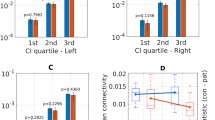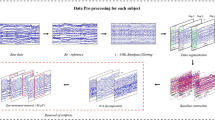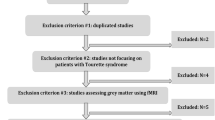Abstract
Tourette’s syndrome (TS) is a developmental neuropsychiatric disorder characterized by motor and vocal tics as well as psychiatric comorbidities. Recently, differences in maturation of cortical networks using functional connectivity metrics have been described for this disorder. However, adult data on subcortical networks are scarce. In particular, the connectivity of the amygdala, for which a role in the pathophysiology of TS has been established, has not been examined so far. We studied 15 adult TS patients (11 male, aged 30.4 ± 9.7y) and 15 age- and sex-matched controls (11 male, aged 32.0 ± 9.3y) in a functional magnetic resonance imaging study at 1.5T using a simple motor task. We corrected for possible confounds introduced by tics, motion and brain-structural differences as well as age, sex, and medication. Task performance was monitored by simultaneous MR-compatible video-recording. Data were analyzed using an independent component approach sensitive to functional connectivity patterns. A stable component comprising both amygdalae could be identified across all subjects. Additionally, we observed a highly significant increase in coupling between/within amygdalae in the TS group when compared to controls, although behavioral data obtained during scanning did not show significant differences. These findings are expected to add to our understanding of the functional architecture of Tourette’s syndrome.

Similar content being viewed by others
References
Freeman RD, Fast DK, Burd L, Kerbeshian J, Robertson MM, Sandor P (2000) An international perspective on Tourette syndrome: selected findings from 3, 500 individuals in 22 countries. Dev Med Child Neurol 42:436–447
Leckman JF, Bloch MH, Scahill L, King RA (2006) Tourette syndrome: the self under siege. J Child Neurol 21:642–649
Rickards H (2009) Functional neuroimaging in Tourette syndrome. J Psychosom Res 67:575–584
Church JA, Wenger KK, Dosenbach NU, Miezin FM, Petersen SE, Schlaggar BL (2009) Task control signals in pediatric Tourette syndrome show evidence of immature and anomalous functional activity. Front Hum Neurosci 3:38
Neuner I, Ludolph A (2009) Tics and Tourette’s syndrome throughout the life span. Nervenarzt 80:1377–1388
Jadresic D (1992) The role of the amygdaloid complex in Gilles de la Tourette’s syndrome. Br J Psychiatry 161:532–534
Ludolph AG, Pinkhardt EH, Tebartz van Elst L, Libal G, Ludolph AC et al (2008) Are amygdalar volume alterations in children with Tourette syndrome due to ADHD comorbidity? Dev Med Child Neurol 50:524–529
Peterson BS, Choi HA, Hao X, Amat JA, Zhu H et al (2007) Morphologic features of the amygdala and hippocampus in children and adults with Tourette syndrome. Arch Gen Psychiatry 64:1281–1291
Peterson BS, Gore JC, Riddle MA, Cohen DJ, Leckman JF (1994) Abnormal magnetic resonance imaging T2 relaxation time asymmetries in Tourette’s syndrome. Psychiatry Res 55:205–221
Balleine BW, Killcross S (2006) Parallel incentive processing: an integrated view of amygdala function. Trends Neurosci 29:272–279
Neuner I, Kellermann T, Stöcker T, Kircher T, Habel U et al (2010) Amygdala hypersensitivity in response to emotional faces in Tourette’s patients. World J Biol Psychiatry (in press)
Albin RL, Mink JW (2006) Recent advances in Tourette syndrome research. Trends Neurosci 29:175–182
Werner, Stöcker, Kellermann, Bath, Beldoch et al (2010) Altered motor network activation and functional connectivity in adult Tourette’s syndrome. Hum Brain Mapp (in press)
Leckman JF, Riddle MA, Hardin MT, Ort SI, Swartz KL et al (1989) The Yale Global Tic Severity Scale: initial testing of a clinician-rated scale of tic severity. J Am Acad Child Adolesc Psychiatry 28:566–573
Oldfield RC (1971) The assessment and analysis of handedness: the Edinburgh inventory. Neuropsychologia 9:97–113
Neuner I, Wegener P, Stoecker T, Kircher T, Schneider F, Shah NJ (2007) Development and implementation of an MR-compatible whole body video system. Neurosci Lett 420:122–127
Jenkinson M, Bannister P, Brady M, Smith S (2002) Improved optimization for the robust and accurate linear registration and motion correction of brain images. Neuroimage 17:825–841
Woolrich MW, Ripley BD, Brady M, Smith SM (2001) Temporal autocorrelation in univariate linear modeling of FMRI data. Neuroimage 14:1370–1386
Jenkinson M, Smith S (2001) A global optimisation method for robust affine registration of brain images. Med Image Anal 5:143–156
Oakes TR, Fox AS, Johnstone T, Chung MK, Kalin N, Davidson RJ (2007) Integrating VBM into the General Linear Model with voxelwise anatomical covariates. Neuroimage 34:500–508
Plessen KJ, Bansal R, Peterson BS (2009) Imaging evidence for anatomical disturbances and neuroplastic compensation in persons with Tourette syndrome. J Psychosom Res 67:559–573
Beckmann CF, Smith SM (2004) Probabilistic independent component analysis for functional magnetic resonance imaging. IEEE Trans Med Imaging 23:137–152
Eickhoff SB, Stephan KE, Mohlberg H, Grefkes C, Fink GR et al (2005) A new SPM toolbox for combining probabilistic cytoarchitectonic maps and functional imaging data. Neuroimage 25:1325–1335
Filippini N, MacIntosh BJ, Hough MG, Goodwin GM, Frisoni GB et al (2009) Distinct patterns of brain activity in young carriers of the APOE-epsilon4 allele. Proc Natl Acad Sci USA 106:7209–7214
Nichols TE, Holmes AP (2002) Nonparametric permutation tests for functional neuroimaging: a primer with examples. Hum Brain Mapp 15:1–25
Smith SM, Nichols TE (2009) Threshold-free cluster enhancement: addressing problems of smoothing, threshold dependence and localisation in cluster inference. Neuroimage 44:83–98
Neuner I, Kupriyanova Y, Stöcker T, Huang R, Posnansky O et al (2010) White-matter abnormalities in Tourette syndrome extend beyond motor pathways. Neuroimage 51:1184–1193
Swanson LW, Petrovich GD (1998) What is the amygdala? Trends Neurosci 21:323–331
Ball T, Rahm B, Eickhoff SB, Schulze-Bonhage A, Speck O, Mutschler I (2007) Response properties of human amygdala subregions: evidence based on functional MRI combined with probabilistic anatomical maps. PLoS ONE 2:e307
Gonzalez-Lima F, Scheich H (1986) Classical conditioning of tone-signaled bradycardia modifies 2-deoxyglucose uptake patterns in cortex, thalamus, habenula, caudate-putamen and hippocampal formation. Brain Res 363:239–256
Roy AK, Shehzad Z, Margulies DS, Kelly AM, Uddin LQ et al (2009) Functional connectivity of the human amygdala using resting state fMRI. Neuroimage 45:614–626
Winstanley CA, Theobald DE, Cardinal RN, Robbins TW (2004) Contrasting roles of basolateral amygdala and orbitofrontal cortex in impulsive choice. J Neurosci 24:4718–4722
Bechara A, Damasio H, Damasio AR, Lee GP (1999) Different contributions of the human amygdala and ventromedial prefrontal cortex to decision-making. J Neurosci 19:5473–5481
Cardinal RN, Parkinson JA, Hall J, Everitt BJ (2002) Emotion and motivation: the role of the amygdala, ventral striatum, and prefrontal cortex. Neurosci Biobehav Rev 26:321–352
Acknowledgments
We thank all patients and their families for participating in the study. We are grateful to the German Tourette Association who supported this study by contributing travel funds. We thank Petra Engels, Barbara Elghahwagi and Gabriele Oefler for their excellent technical assistance. This work was funded by a fellowship to I.N. (“Rotationsprogramm”) of the Medical Faculty, RWTH Aachen University (Rheinisch-Westfälische Technische Hochschule), Aachen, Germany. The Institute of Neuroscience and Medicine (INM-4) acknowledges funding by the German Ministry for Education and Research (BMBF) and Siemens for the 9.4T project.
Conflict of interest
Cornelius J. Werner, Tony Stöcker, Thilo Kellermann, and Irene Neuner report no conflict of interest. N. Jon Shah reports funding from the BMBF and Siemens for the 9.4T MR/PET (magnetic resonance/positron emission tomography) project. Frank Schneider received compensation as a consultant for Janssen-Cilag, AstraZeneca, and Otsouka. Frank Schneider received compensation for scientific talks or contribution in a prize jury by Janssen-Cilag, Wyeth, and AstraZeneca. Frank Schneider received funding for investigator initiated projects from AstraZeneca, Lilly and Pfizer.
Author information
Authors and Affiliations
Corresponding author
Rights and permissions
About this article
Cite this article
Werner, C.J., Stöcker, T., Kellermann, T. et al. Altered amygdala functional connectivity in adult Tourette’s syndrome. Eur Arch Psychiatry Clin Neurosci 260 (Suppl 2), 95–99 (2010). https://doi.org/10.1007/s00406-010-0161-7
Received:
Accepted:
Published:
Issue Date:
DOI: https://doi.org/10.1007/s00406-010-0161-7




